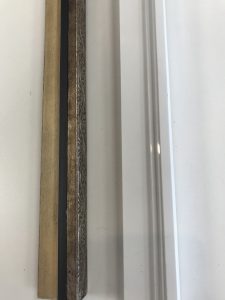
01 Sep Conservation Know-How, 2/3 Moisture!
In our previous romp into “not ruining your art: conservation framing” we covered Danger #1:: the issues light poses and how tempered glass can totally save the day.
[ Missed that article? Read about it now! ]
In this blog post we’ll cover danger #2: MOISTURE.
And we’re not explicitly talking about like a flood here, which is also no good, but rather the humidity fluctuations caused by heat & humidity.
What are the risks of moisture on art? The most common ones are that moisture will create condensation on the inside of the glass- staining and discoloring the image, causing the art and glass to fuse together, and warping both the paper and the matting. All bad things.
So firstly, we need to keep that glass OFF the art for a successful conservation strategy.
There are several ways to go about this. The most traditional is the use of a mat or liner, which by its nature, lifts the glass away from the art.

The other solid option is to use what are called “frame spacers”.
Frame spacers come in clear or black and sit under the glass, creating a space for the artwork to sit below- not pressed against the glass. Allowing for this space between the glass and artwork is also paramount in framing original works done with non-fixed materials such as pastels. If you were to put glass right on a pastel piece, you will see a distinct chalky transfer onto the glass, and it won’t look good. (It’s also ideal to use a fixative with any sort of dry media to avoid these issues)
Check out these pictures for how the anatomy of using frame spacers work:


We also need to do a couple of other things to protect our artwork from dreaded moisture damage.
Say also you live in a place with a lot of humidity, or if you were to be putting framed artwork in the bathroom, there is one key piece for when it comes time to hang your art: frame bumper pads.
What bumper pads do is to create breathing space between the wall and the framed piece- allowing air to flow through and preventing mildew and mold to build up behind the artwork.

I mean, in an ideal world, you should try to maintain a stable humidity level in your home- they say 55% is the sweet spot. And then also to not keep irreplaceable artworks in high humidity zones in the first place. Regardless, take the above precautions and you’ll save yourself a world of hurt.
Wanna get really hardcore? Some really tech-savvy contemporary framers are working with anoxic framing displays. I’m not going to get too into this but essentially its about creating an oxygen-free environment- preventing oxidation and hydrolysis (moisture). If you’re interested in reading more, check out Tate’s research into anoxic displays here.



